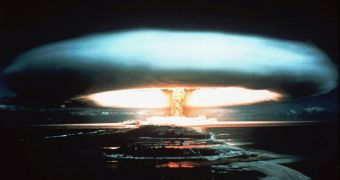Global or not, a nuclear war would kill us all. And if nuclear weapons didn't do the job, then the Sun would. According to recent studies, a regional global war would cause the ozone layer of the Earth to be destroyed in as little as a decade, all living beings being at the mercy of the Sun's ultraviolet rays. Ultraviolet light has the ability to alter the human DNA, but other organisms may be at risk as well.
100 Hiroshima-sized bombs would be enough to determine substantial changes in Earth's atmosphere. Take India and Pakistan for example; both have a nuclear arsenal of about 50 nuclear warheads bearing 15 kilotons of explosive material. In case the disagreements between the two countries reach very high levels as to make use of their entire nuclear arsenal, global disaster is soon to follow.
"The figure of 100 Hiroshima-sized bombs compares pretty accurately to the approximately 110 warheads that both states reportedly possess between them," says professor of non-proliferation and international security in the War Studies Group at King's College, Wyn Bowen.
Michael Mills of the University of Colorado at Boulder, US, and colleagues used computer models to study how 100 Hiroshima-sized bombs would affect the atmosphere.
Aftermath
Michael Mills from the University of Colorado reckons that such a nuclear war in South Asia would decay about 40 percent of the ozone layer in the middle latitudes and 70 percent in the high latitudes of the northern hemisphere.
"The models show this magnitude of ozone loss would persist for five years, and we would see substantial losses continuing for at least another five years," says Mills.
Mills extracted his results from computer models. Previous models were created during the 1980s, however those investigations revealed that impact of the nuclear detonations would be much more moderate. This might be because the old models do not take into consideration the columns of soot rising at altitudes of 80 kilometers into Earth's atmosphere, as Mills considers.
Once the soot is released into the upper atmosphere, it would block and absorb most of the solar energy, thus determining a heating of the surrounding atmosphere, process that facilitates the reaction between nitrogen oxides and ozone.
UV light damage
Ultraviolet rays influx, caused by the decay of the ozone layer, would increase by 213 percent, causing DNA damage, skin cancers and cataract in most - if not all - living beings. Alternatively, plants would suffer damage twice, as the current due to ultraviolet light.
"By adopting the Montreal Protocol in 1987, society demonstrated it was unwilling to tolerate a small percentage of ozone loss because of serious health risks. But ozone loss from a limited nuclear exchange would be more than an order of magnitude larger than ozone loss from the release of gases like CFCs," says co-author of the study Brian Toon.
It starts with one
"This study is very conservative in its estimates. It should ring alarm bells to remind us all that nuclear war can destroy our world far faster than carbon dioxide emissions," says Dan Plesch, of the Centre for International Studies and Diplomacy at the School of Oriental and African Studies, UK, although he notes that no one knows how likely a nuclear exchange is.
Nevertheless, it is not all about India and Pakistan, other countries have much more significant nuclear arsenal than the two, such as the US, Russia and Israel. Even some hostile powers around the world have nuclear capabilities, whether the international community is ready or not to admit it, Bowen reckons. If India and Pakistan were to deploy their arsenal, then they would launch all warheads at once, in order to avoid the destruction of the nuclear weapons before being launched.
Nonetheless, it is highly unlikely that the two would ever engage in such a 'dirty' dispute.

 14 DAY TRIAL //
14 DAY TRIAL //